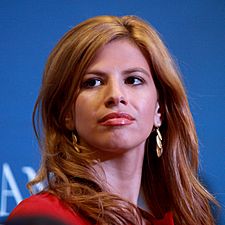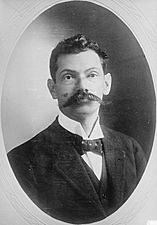Honduran Americans facts for kids
Quick facts for kids Total population |
|
|---|---|
| 1,083,540 (2019) 0.33% of the U.S. population (2019) |
|
| Regions with significant populations | |
| Languages | |
| American English, Honduran Spanish, Garifuna | |
| Religion | |
| Predominantly Roman Catholic Minority Protestantism |
|
| Related ethnic groups | |
| other Hispanic Americans |
Honduran Americans (Spanish: hondureño-americano, norteamericano de origen hondureño or estadounidense de origen hondureño) are Americans of full or partial Honduran descent. Hondurans are the eighth largest Hispanic group in the United States and the third largest Central American population, after Salvadorans and Guatemalans. Hondurans are concentrated in Texas, Florida and California, and are now the largest immigrant group in Louisiana.
Contents
History
19th century
The first Hondurans came to the United States during the late 18th and early 19th centuries, by the time Honduras was known as the Intendencia de Comayagua, which later in 1820 changed its name to the province of Comayagua, located in the Viceroyalty of New Spain. The province of Comayagua later gained its independence from the Spanish Crown, founding itself as the republic of Honduras. It then for a short time became a part of the Mexican empire between 1822 and 1823, when the empire started to collapse. Honduras then decided to become part of the Central American federation from 1823 to 1838.
20th century

By the beginning of the century, there was a closer relation between Honduras and the United States, permitting U.S. and Honduran citizens move from one country to another due the fact of the banana companies, one Honduran American of this era was Steve Van Buren, born in the city of la Ceiba, that by the time had an economic growth. Despite dictatorships and wars, most Hondurans, which were mostly farmers and workers, had a stable way of life with few social changes until the mid and late 20th century when constant far-right coups started. All periods of conflict have led to minor waves of Honduran emigration to the United States. Such was the case after the 1956 military coup, however not very significant due the fact that in the 60s and 70s Honduras was one on the lowest crime rates countries in the globe.
Hondurans immigrated to the United States in the 1960s, primarily to Miami, New York City, and Los Angeles. The main reason for Hondurans to leave their country during that decade was to escape poverty of the rural areas and to escape the military regimes that were against personal freedom in hopes of establishing a better life in the United States. Honduran migration as we know it started until the late 1980s when Honduras started an economic and political decline. Other minor Honduran migration was by the Jewish-Hondurans that left the country after the 2009 coup due to the rise of political tension.
Present-day
Hondurans are one of the biggest Latino communities among Mexicans, Puerto Ricans, Dominicans, and Cubans. The metropolitan areas with most Honduran-Americans are Houston, New York City, Miami, Indiana, and Washington, D.C. Most of them had undertaken in business, such as the opening of coffee shops, others take advantage of their university studies to provide services to the American society. Many Hondurans migrated legally, many have joined undocumented Mexican migrants among other Central American people that cross Mexico, in 2018 came the migrant caravan.
Causes
Different historians, sociologists, and politologists have made different hypotheses for the cause of the Honduran migrations, some point to the institutional corruption, others point to the fact that Honduras is still controlled by a tiny oligarchy that has a monopoly on the country, others expressed that Honduras is the example of the failure of the neo-liberal model and the privatization of state owned industries. However, the most popular hypothesis involves the Honduran economic system and U.S. military interventions during the past decades.
Cold War roots

Many analysts point out that one of the main, if not the main, factor in the current massive migration of Hondurans beginning in the late 80's early 90's was the United States military occupation in Honduras and its enormous influence on Honduras since the time of the Reagan presidency. The 1980s were a period full of invasion and occupation of U.S. soldiers in Honduran soil during the Central American Crisis.
The United States under the Reagan administration government ordered hundreds of U.S. soldiers that were stationed at the nearby Palmerola Base during that period under the excuse of stopping socialism in Central America. It was another mission of the U.S. to wipe out any communism that was occurring in Honduras. President Reagan saw Honduras as a strategic point to grow U.S. influence in the Region. This event was key to the relationship between the U.S. and Honduras.
Ties to American companies

Others point out that the start of migration of Hondurans is rooted in U.S. based banana and mining companies such as Standard Fruit Company and Rosario Mining Company. These companies in words of some analysts transformed Honduras in a kind U.S. colony similar to Cuba and Puerto Rico during the early 20th century and companies exploited many of their workers:
"Honduran peasants had no hope of access to their nation's good soil".
Many Honduran-Americans are sons and grandsons of farm laborers who first established themselves in the largest U.S. cities, in which they had support networks from the Honduran-American communities. In the late 1980s and 1990s, most Honduran Americans lived in New Orleans (50,000), New York City (33,000), Los Angeles (24,000), and Miami (18,000). In 2000, Hondurans grew to be the third largest immigrant group from Central America.
Contributions to American society
Arts
Many Honduran Americans have contributed to the world of art, film, and television, such as Carlos Mencia or America Ferrera, and in fashion, providing Honduran cultural features in their designs. Many young Honduran-Americans study in art institutes various artistic disciplines.
Music
They are two slopes of Honduran music, La Punta, of Afro-Caribbean origin, more originally from the Garifuna population, and marimba music, more connected to the mestizo-criollo identity of the country, however Honduras has its versions of other Latin genres such as salsa. Other Hondurans contributed to rock music, due the boom of rock in Honduras during the 80's and 90's.
Military service
Honduran-Americans have actively participated in U.S. military service since World War II. Some of them have participated in North Africa allied operations, the Pacific War, and the occupation of Japan. A well-known story is the one of the Honduran U.S. soldier Luis Alemán Gomez that was part of the Allied occupation forces in Japan. A total of 13.7 percent of native (U.S.) Honduran-American males older than 16 years are in the military. Additionally, 769 Honduran-American non-citizen males serve in the military.
Socioeconomics
Usually, Honduran-Americans live in areas with high economic growth and demand for employment in construction, domestic services, and other industries. Many Honduran-Americans suffer discrimination, as other Hispanic groups do especially Afro-Hondurans.
Honduran-American girls tend to spend more years in school than Honduran-Americans boys, in part due to pressure by their families on boys to start working at age 12 or 14. A total of 1,091 Honduran-Americans have a master's degree graduated in U.S. colleges, 862 have other professional degrees, and 151 have a doctoral degree. The majority of these individuals are women.
Demographics
According to the 2010 United States Census there are 633,401 Hondurans living in the United States. By 2011, the number of Hondurans estimated to reside in the United States by the Census Bureau's American Community Survey was 702,000. In 2014, according to Pew Research, "60% of 573,000 Honduran immigrants in the U.S. are unauthorized".
According to the 2020 census, there were 1,061,585 Honduran Americans living in the U.S.
The 10 U.S. states with the largest Honduran populations in 2020 are:
- Texas – 168,578 (0.5% of the state population)
- Florida – 153,308 (0.7% of the state population)
- California – 102,491 (0.2% of the state population)
- New York – 93,056 (0.4% of the state population)
- North Carolina – 57,822 (0.5% of the state population)
- Louisiana – 55,915 (0.6% of the state population)
- New Jersey – 55,819 (0.5% of the state population)
- Virginia – 53,664 (0.6% of the state population)
- Maryland – 44,183 (0.7% of the state population)
- Georgia – 31,832 (0.2% of the state population)
According to ACS estimates For 2017-2021, there were 684,000 Honduran immigrants in the United States of America, the top counties of which were:
1) Harris County, Texas -‐-----‐------------------‐ 71,500
2) Miami - Dade County, Florida --‐-----‐----- 46,800
3) Los Angeles County, California ----------- 35,700
4) Dallas County, Texas --------------------------- 18,600
5) Jefferson Parish, Louisiana ---------------- 17,000
6) Mecklenburg County, N.C. ------------------- 14,300
7) Broward County, Florida ---------------------- 13,900
8) Bronx Borough, New York -------------------- 12,600
9) Palm Beach County, Florida ------------------- 9,800
10) Queens Borough, New York ------------------ 8,500
11) Suffolk County, New York --------------------- 8,000
12) Nassau County, New York -------------------- 8,000
13) Prince George's County, Maryland -------- 7,800
14) Fairfax County, Virginia ------------------------- 7,700
15) Cook County, Illinois ------------------------------ 7,400
16) Montgomery County, Maryland ---‐--------- 7,100
17) Hudson County, New Jersey ----------------- 7,000
18) Travis County, Texas ----------------------------- 6,700
19) Brooklyn Borough, New York ---------------- 6,600
20) Gwinnett County, Georgia --------------------- 6,600
21) Suffolk County, Massachusetts -----‐------ 6,100
22) Hillsborough County, Florida ----------------- 6,100
23) Bexar County, Texas ------------------------------ 6,000
24) Tarrant County, Texas -----------------------‐---- 5,100
25) Davidson County, Tennessee ---------------- 4,800
Notable people
- Alessandro Castro – soccer player
- Teofilo Colon Jr. – photographer, filmmaker, writer, and journalist
- Ronnie Aguilar – basketball player
- David Archuleta – runner-up of American Idol Season 7
- Michael Benjamin (investor) – private investor focusing on Internet companies; was a Republican candidate for the United States Senate in 2004
- Bianca Del Rio – actor, comedian, costume designer, and drag queen
- Brandon Escobar – wrestler
- Empress Of – singer
- Kat Fajardo – author
- America Ferrera – film actress (Real Women Have Curves, The Sisterhood of the Traveling Pants, Ugly Betty)
- Michelle Fields – political journalist, Huffington Post contributor
- Brian Flores – former Head Coach for the Miami Dolphins
- Samuel Gómez – soccer player
- Illich Guardiola – American actor
- Ali Hall – soccer player
- Teófimo López – professional boxer, world lightweight champion since 2020
- Dewan Hernandez – basketball player
- Maximiliano Hernández – film actor (Captain America: The Winter Soldier, Sicario, The Last Ship)
- Maity Interiano – journalist, entertainment reporter and television producer
- Skai Jackson – actress
- Karrie Martin – entrepreneur
- Walmer Martinez – soccer player
- Annia Mejia – soccer player
- Juan Carlos Obregón Jr. – soccer player
- Brina Palencia – voice actress, ADR director, and singer primarily known for her work for Funimation Entertainment/OkraTron 5000.
- Francia Raisa – actress
- Taxstone – television and podcast personality
- Andres Serrano – photographer and artist. He is of Honduran and Afro-American descent.
- Hype Williams – Billboard and MTV VMA award-winning music video and film director
- Sauce Walka – rapper
- Sha EK – rapper born in Melrose, Bronx
See also
 In Spanish: Inmigración hondureña en los Estados Unidos para niños
In Spanish: Inmigración hondureña en los Estados Unidos para niños



